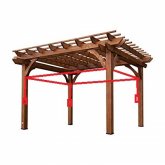my idea is to buy some box(metal) and put all the components inside and place it below the table(extra protection from water)
The A photo doesn't have a table, but that would certainly fill in the "empty" space. Do you have any images representing the final idea?
I'm thinking the table top could be on a pedestal, and all the gear hidden inside. The wire from the panels hidden in a "hollow" support post (e.g., four 2x4's rather than a single 4x4's so there's a hidden hole in the center) then run underneath to the pedestal. This way you don't have to worry about squirrels or students picking at the wire's insulation. I'd also use a sealed inverter so you don't have to worry about ventilation/weather.
As to the battery size, it really depends on how much power you expect to be drawn during non-sun hours. For example, let's say you want six students with 6 laptops, each drawing 50 watts of power and you expect it to be used on average of 10 hours a day. Let's also say you want a string of led christmas type lights to run 24x7 to jazz it up and they use 10 watts. So you need:
6 laptops x 50 watts x 10 hours = 3000 watt hours
24 hrs x 10 watts = 240 watt hours.
Let's assume an 80% efficiency for the battery, inverters, and wiring; so total battery power is 3240 / .8 = 4000 watt hours.
Let's assume from the
insolation map you get 5 for the equivalent "full" sun hours, so you'd need 3240 / 5 / .8 = 810 watts of panels. Or 3 of the 325 watt Canadian Solar panels.
For the battery, let's assume 12V, so 4000 / 12 ~= 350 Ah. Or if you want an extra day to insure it works through a gloomy day that's 700 Ah @ 12V.
If you want to stick with those 60 Ah Victron Gel lead acid batteries you'd want to limit the depth of discharge to 50%, so that bumps it up to 700 or 1400 Ah. At 60 Ah per battery, you'd need 12 to 24 and that's a lot to put in parallel. Even then you'll probably only get 5 years out of them. This is where lithium shines, longer cycles and greater depth of discharge.
If you want it to work in cold weather, you'll need to look at the data sheet to see how much it'll lose with temperature. You should probably also check the draw rate; a 60 Ah lead acid battery is only 60 Ah if you're pulling less than 3 amps from each battery. See the
Battery FAQ for all the fun details.







